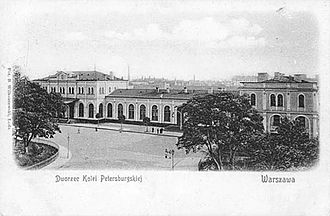Saint Petersburg–Warsaw railway
This article includes a list of general references, but it remains largely unverified because it lacks sufficient corresponding inline citations. (August 2021) |
| Warsaw–St. Petersburg Railway | ||||||||||||||||||||||||||||||||||||||||||||||||||||||||||||||||||||||||||||||||||||||||||||||||||||||||||||||||||||||||||||||||||||||||||||||||||||||||||||||||||||||||||||||||||||||||||||||||||||||||||||||||||||||||||||||||||||||||||||||||||||||||||||||||||||||||||||||||||||||||||||||||||||||||||||||||||||||||||||||||||||||||||||||||||||||||||||||||||||||||||||||||||||||||||||||||||||||||||||||||||||||||||||||||||||||||||||||
|---|---|---|---|---|---|---|---|---|---|---|---|---|---|---|---|---|---|---|---|---|---|---|---|---|---|---|---|---|---|---|---|---|---|---|---|---|---|---|---|---|---|---|---|---|---|---|---|---|---|---|---|---|---|---|---|---|---|---|---|---|---|---|---|---|---|---|---|---|---|---|---|---|---|---|---|---|---|---|---|---|---|---|---|---|---|---|---|---|---|---|---|---|---|---|---|---|---|---|---|---|---|---|---|---|---|---|---|---|---|---|---|---|---|---|---|---|---|---|---|---|---|---|---|---|---|---|---|---|---|---|---|---|---|---|---|---|---|---|---|---|---|---|---|---|---|---|---|---|---|---|---|---|---|---|---|---|---|---|---|---|---|---|---|---|---|---|---|---|---|---|---|---|---|---|---|---|---|---|---|---|---|---|---|---|---|---|---|---|---|---|---|---|---|---|---|---|---|---|---|---|---|---|---|---|---|---|---|---|---|---|---|---|---|---|---|---|---|---|---|---|---|---|---|---|---|---|---|---|---|---|---|---|---|---|---|---|---|---|---|---|---|---|---|---|---|---|---|---|---|---|---|---|---|---|---|---|---|---|---|---|---|---|---|---|---|---|---|---|---|---|---|---|---|---|---|---|---|---|---|---|---|---|---|---|---|---|---|---|---|---|---|---|---|---|---|---|---|---|---|---|---|---|---|---|---|---|---|---|---|---|---|---|---|---|---|---|---|---|---|---|---|---|---|---|---|---|---|---|---|---|---|---|---|---|---|---|---|---|---|---|---|---|---|---|---|---|---|---|---|---|---|---|---|---|---|---|---|---|---|---|---|---|---|---|---|---|---|---|---|---|---|---|---|---|---|---|---|---|---|---|---|---|---|---|---|---|---|---|---|---|---|---|---|---|---|---|---|---|---|---|---|---|---|---|---|---|---|---|---|---|---|---|---|---|---|---|---|---|---|---|---|---|---|---|---|---|---|---|---|---|
 Warsaw Wileńska Station (1862–1915) | ||||||||||||||||||||||||||||||||||||||||||||||||||||||||||||||||||||||||||||||||||||||||||||||||||||||||||||||||||||||||||||||||||||||||||||||||||||||||||||||||||||||||||||||||||||||||||||||||||||||||||||||||||||||||||||||||||||||||||||||||||||||||||||||||||||||||||||||||||||||||||||||||||||||||||||||||||||||||||||||||||||||||||||||||||||||||||||||||||||||||||||||||||||||||||||||||||||||||||||||||||||||||||||||||||||||||||||||
| Technical | ||||||||||||||||||||||||||||||||||||||||||||||||||||||||||||||||||||||||||||||||||||||||||||||||||||||||||||||||||||||||||||||||||||||||||||||||||||||||||||||||||||||||||||||||||||||||||||||||||||||||||||||||||||||||||||||||||||||||||||||||||||||||||||||||||||||||||||||||||||||||||||||||||||||||||||||||||||||||||||||||||||||||||||||||||||||||||||||||||||||||||||||||||||||||||||||||||||||||||||||||||||||||||||||||||||||||||||||
| Track gauge | (Warsaw–Hrodna) 1,435 mm (4 ft 8+1⁄2 in) (Hrodna–Saint Petersburg) 1,520 mm (4 ft 11+27⁄32 in) | |||||||||||||||||||||||||||||||||||||||||||||||||||||||||||||||||||||||||||||||||||||||||||||||||||||||||||||||||||||||||||||||||||||||||||||||||||||||||||||||||||||||||||||||||||||||||||||||||||||||||||||||||||||||||||||||||||||||||||||||||||||||||||||||||||||||||||||||||||||||||||||||||||||||||||||||||||||||||||||||||||||||||||||||||||||||||||||||||||||||||||||||||||||||||||||||||||||||||||||||||||||||||||||||||||||||||||||
| ||||||||||||||||||||||||||||||||||||||||||||||||||||||||||||||||||||||||||||||||||||||||||||||||||||||||||||||||||||||||||||||||||||||||||||||||||||||||||||||||||||||||||||||||||||||||||||||||||||||||||||||||||||||||||||||||||||||||||||||||||||||||||||||||||||||||||||||||||||||||||||||||||||||||||||||||||||||||||||||||||||||||||||||||||||||||||||||||||||||||||||||||||||||||||||||||||||||||||||||||||||||||||||||||||||||||||||||
Saint Petersburg–Warsaw Railway ((Russian: Санкт-Петербурго-Варшавская железная дорога) (transliteration: Sankt-Peterburgo–Varshavskaya zheleznaya doroga)) is a 1,333 km (828 mi) long railway, built in the 19th century by the Russian Empire to connect Russia with Central Europe. At the time the entire railway was within Russia, as Warsaw was under a Russian partition of Poland. Due to territorial changes, the line now lies within five countries and crosses the eastern border of the European Union three times. Therefore, no passenger trains follow the entire route. Travel by passenger train between Saint Petersburg and Warsaw today (2010) passes Brest instead.
History[]
Construction[]
In February 1851 the Tsarist Government of Russia made a decision to build the St. Petersburg–Warsaw railway line with a length of approximately 1,250 kilometres. It was built to Russian gauge. Construction was completed in 1862.

The first section of the railway was completed in 1853 between Saint Petersburg and Gatchina, with daily scheduled train service started on 31 October 1853. On 19 July 1858 the first train arrived in Pskov.[1]
In May 1858, construction started near Vilnius on the first section of 19 kilometers. On 1 May 1859 the ground works started along the entire route Daugavpils–Vilnius–Lentvaris–Kaunas–Kybartai. The end of summer of 1860 marked the end of the construction of the Ostrov-Daugavpils–Vilnius railway. The first train from Daugavpils arrived in Vilnius on 16 September 1860. In 1861, this branch was completed to the Prussian border, and between Verzhbolovo Station in Kybartai and Eydtkuhnen in Prussia (now Chernyshevskoye in Russian Kaliningrad Oblast) the first junction between Russian gauge and standard gauge railway systems was built, with rails in both gauges between the border stations.
The construction of the section from Lentvaris to Warsaw was completed on 15 December 1862.
The first locomotives for the St. Petersburg–Warsaw railway were bought in England, France, and Belgium. They were “G” class 0-6-0s with two cylinders. They were produced in Manchester in 1857, in Paris in 1860, and in Belgium in 1862. Their weight was 30–32 tons.

The portion between Vilnius and Warsaw was rebuilt in the standard gauge in the 1920s when that area belonged to Poland. The railway was partly destroyed during both world wars.

Present[]
The section of the line between Zielonka and Białystok forms part of Rail Baltica. Since 2014 the line is being modernised to ultimately allow passenger trains to run at 200 km/h (125 mph) and freight trains at 120 km/h (75 mph), works include renewal of tracks and overhead lines, replacing level crossings with tunnels or overpasses and installation of ETCS level 2.[2]
See also[]
References[]
- ^ "Put' k Varshave" Путь к Варшабе [Route to Warsaw] (in Russian). Archived from the original on 13 January 2010. Retrieved 11 February 2011.
- ^ "O inwestycji". PKP PLK Rail Baltica (in Polish).
Sources[]
- "Line Riga–Valka celebrates 120 years". "Latvijas dzelzceļš". Latvian State Railways. Archived from the original on 27 December 2010. Retrieved 28 July 2009.
In 1907 Baltic Railway was merged with St.Petersburg–Warsaw Railway and was made the Northwest Railways
- Rakov, V. A. (Vitaliĭ Aleksandrovich) (1995). Lokomotivy otechestvennykh zheleznykh dorog 1845-1955 Локомотивы отечественных железных дорог 1845-1955 [National railways locomotives 1845–1955] (in Russian). Moscow: Transport. ISBN 5-277-00821-7.
- Railway lines in Poland
- Railway lines in Belarus
- Railway lines in Lithuania
- Railway lines in Latvia
- Railway lines in Russia
- Establishments in Congress Poland
- 19th-century establishments in Poland
- 19th-century establishments in the Russian Empire
- International railway lines
- 1520 mm gauge railways in Russia
- 5 ft gauge railways in Latvia
- 1520 mm gauge railways in Lithuania
- 1520 mm gauge railways in Poland
- 1520 mm gauge railways in Belarus
- 1862 establishments in the Russian Empire
- 1850s establishments in the Russian Empire